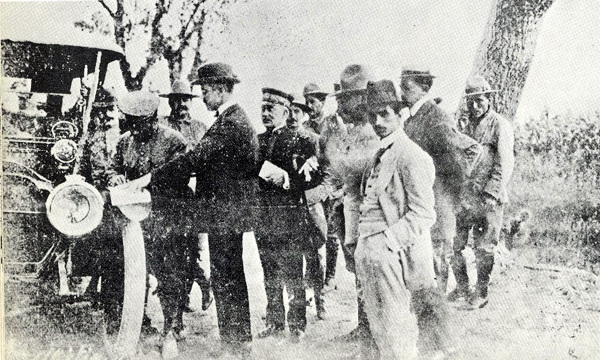New Actor on the Scene: Venustiano Carranza
Venustiano Carranza was a well-to-do cattle rancher and rising politician in the state of Coahuila, bordering Texas. During the Porfiriato, he had been a municipal president and, with the support of Bernardo Reyes, governor of the neighboring state of Nuevo León, he became a state legislator and federal senator. In 1909, he sought to be governor, but Díaz, who virtually named state governors, didn't select him. So in 1910, he supported Francisco Madero's presidential candidacy against Díaz. When Madero became president, he appointed Carranza governor of Coahuila. When Huerta seized power, Carranza had his state legislature declare the state in rebellion and, joining with governors in Sonora and other northern states, he organized the "Constitutional Army", declaring himself "Primer Jefe", First Chief.
Álvaro Obregón and the Army of the Northwest (Sonora)
When Sonora forces joined with Carranza in Coahuila in September of 1913, the Primer Jefe named Obregón head of the Army of the Northwest, with responsibility for Sonora, Sinaloa, Durango, Chihuahua, and Baja California. In November 1913, Obregón's forces captured Culiacán, Sinaloa, thus securing the supremacy of the Constitutional Army in the entire region of northwestern Mexico.
Pancho Villa and the Division of the North
Francisco "Pancho" Villa (who had fled to the U.S. in December 1912, after being jailed for insubordination against Huerta during the fight against Orozco) returned to Mexico and also joined Carranza. He was made general of la División del Norte, the Division of the North. Against Carranza's wishes, local military commanders in Chihuahua, in the center-north of the country, elected him provisional governor of the state of Chihuahua.
As governor of Chihuahua, Villa used various unique methods to raise funds for his drive to the south against Huerta's Federal Army. He printed the state's own currency and decreed this paper money was to be traded and accepted at par with gold Mexican pesos. He forced the wealthy to give loans. He confiscated gold from several banks and robbed trains carrying silver. He also appropriated lands of the hacendados, hacienda owners.
Using this wealth, Villa expanded and modernized his forces, purchasing draft animals, cavalry horses, arms, ammunition, mobile hospital facilities, and other supplies, as well as rebuilding the railroad south from Chihuahua City. He also recruited fighters from Chihuahua and Durango to build the División del Norte, which became the most powerful and feared military unit in all of Mexico. He used the rebuilt railroad to transport soldiers and artillery south. In a series of battles at Gómez Palacio in Durango and Torreón in Coahuila, he defeated Federal Army Forces.
The Race Is On!
At this point, a final, grand strategy was formulated for the Constitutional Army, a three-pronged attack south to Mexico City: (1) Obregón would advance southeast along the western railroad; (2) Pancho Villa would advance south along the central railroad; and (3) Pablo González Garza would advance south along the eastern railroad.
In March, 1914, Carranza ordered Villa not to proceed south of Torreón but, instead, to go west to attack Saltillo, Coahuila. If Villa did not comply, Carranza threatened to cut off Villa's coal supply, which would immobilize his supply trains. This was widely seen as an attempt by Carranza to divert Villa from a direct assault on Mexico City in order to allow Carranza's forces under Álvaro Obregón, driving in from the west via Guadalajara, to take the capital first. Villa complied with Carranza's order and captured the less important city of Saltillo. He then offered his resignation.
Obregón began his march in April. In May, Carranza instructed Obregón to increase the pace of his southern campaign to ensure that he beat Pancho Villa's División del Norte to Mexico City. Obregón moved his troops from Topolobampo, Sinaloa, to blockade Mazatlán, and then to Tepic, where he cut off the railroad between Guadalajara, Jalisco, and Colima, thus leaving both of these ports isolated.
Villa's Battle of Zacatecas
Meanwhile, Villa's staff officers argued for him to withdraw his resignation, defy Carranza's orders and proceed to attack Zacatecas, capital of the state of Zacatecas in the virtual center of the country. A strategic railroad station on the route to Mexico City, Zacatecas was heavily defended by Federal troops and considered nearly impregnable. Since the colonial era, Zacatecas was the source of much of Mexico's silver and, hence, a source of funds for whoever held it.
Villa accepted his staff's advice and cancelled his resignation. On June 23, defying Carranza, the División del Norte attacked Zacatecas. Charging up steep slopes, Villa's forces defeated the Federales in the Toma de Zacatecas, Taking of Zacatecas, the single bloodiest battle of the Revolution. Federal casualties numbered approximately 7,000 dead; 5,000 wounded. The number of civilian casualties, assumed to be considerable, was unknown.
Zapata Attacks From the South
In May of 1914, the Zapatistas took Jojutla, Morelos, south of Cuernavaca, from the Federales. They also laid siege to Cuernavaca. By early July, Zapata’s forces had taken the southern edge of the Federal District, occupying Milpa Alta and Xochimilco [outer boroughs], and were poised to move into the capital.
End Game: Obregón and Carranza get to Mexico City First
In early July, Obregón moved south to Orendaín, Jalisco, where his troops defeated federal troops, leaving 8,000 dead.
On July 14, 1914, Huerta left the country. Obregón moved to Teoloyucan, Mexico State, and on August 11, on the mudguard of a car, Obregón signed the treaties that ended the Huerta regime.
 |
| "Signing of the Treaties of Teoloyucan" by Jisaf gc15d - Own work. Licensed under CC BY-SA 3.0 via WikiCommons |
On August 16, 1914, Obregón and 18,000 of his troops marched triumphantly into Mexico City. Carranza entered the city on August 20.
Other chapters:
Mexican Revolution Protagonists and Antagonists Dictator Porfirio Díaz Triggers a Revolution Short and Tragic Presidency of Francisco Madero Venustiano Carranza Wins Against Pancho Villa and Emiliano Zapata Post-War Power Struggles: The End of Almost Everyone
No comments:
New comments are not allowed.